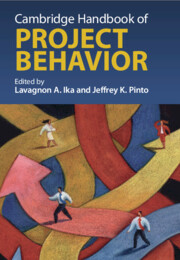Book contents
- Cambridge Handbook of Project Behavior
- Cambridge Handbook of Project Behavior
- Copyright page
- Contents
- Figures
- Tables
- Contributors
- Introduction
- Part I Guiding Principles
- Chapter 1 The Rise and Fall of the Planning Fallacy
- Chapter 2 Unveiling the Hiding Hand
- Chapter 3 Voyages of Discovery
- Chapter 4 Temporal Structuring and Project Behavior
- Chapter 5 Managing Project Complexity and Uncertainty through Dynamic and Systemic Stakeholder Modeling
- Part II Deviating from Plans
- Part III Practical Tips
- Index
- References
Chapter 5 - Managing Project Complexity and Uncertainty through Dynamic and Systemic Stakeholder Modeling
from Part I - Guiding Principles
Published online by Cambridge University Press: 22 November 2025
- Cambridge Handbook of Project Behavior
- Cambridge Handbook of Project Behavior
- Copyright page
- Contents
- Figures
- Tables
- Contributors
- Introduction
- Part I Guiding Principles
- Chapter 1 The Rise and Fall of the Planning Fallacy
- Chapter 2 Unveiling the Hiding Hand
- Chapter 3 Voyages of Discovery
- Chapter 4 Temporal Structuring and Project Behavior
- Chapter 5 Managing Project Complexity and Uncertainty through Dynamic and Systemic Stakeholder Modeling
- Part II Deviating from Plans
- Part III Practical Tips
- Index
- References
Summary
Effective stakeholder management is seen as a critical element of project management, and yet, despite the growing body of literature projects still experience stakeholder challenges. Why is this the case? In seeking to answer this question, this chapter commences with an exploration of three key questions – a) who the project stakeholders are, b) how to effectively manage them within the contest of their social networks, and c) when to manage them. Based on the exploration, the chapter then considers complexities associated with stakeholder management processes (that is the socio-political considerations), content (the myriad views on interconnected and potentially competing values and issues) and the inherent dynamic nature of the stakeholder landscape (reflecting relationships, churn, and norms). The chapter concludes by reflecting on four emergent and interconnected paradoxes using the three complexity lenses to provide recommendations for management.
Information
- Type
- Chapter
- Information
- Cambridge Handbook of Project Behavior , pp. 84 - 96Publisher: Cambridge University PressPrint publication year: 2025
References
Accessibility standard: WCAG 2.0 A
Why this information is here
This section outlines the accessibility features of this content - including support for screen readers, full keyboard navigation and high-contrast display options. This may not be relevant for you.Accessibility Information
Content Navigation
Allows you to navigate directly to chapters, sections, or non‐text items through a linked table of contents, reducing the need for extensive scrolling.
Provides an interactive index, letting you go straight to where a term or subject appears in the text without manual searching.
Reading Order & Textual Equivalents
You will encounter all content (including footnotes, captions, etc.) in a clear, sequential flow, making it easier to follow with assistive tools like screen readers.
You get concise descriptions (for images, charts, or media clips), ensuring you do not miss crucial information when visual or audio elements are not accessible.
You get more than just short alt text: you have comprehensive text equivalents, transcripts, captions, or audio descriptions for substantial non‐text content, which is especially helpful for complex visuals or multimedia.
You can access graphs or charts in a text or tabular format, so you are not excluded if you cannot process visual displays.
Visual Accessibility
You will still understand key ideas or prompts without relying solely on colour, which is especially helpful if you have colour vision deficiencies.
You benefit from high‐contrast text, which improves legibility if you have low vision or if you are reading in less‐than‐ideal lighting conditions.
